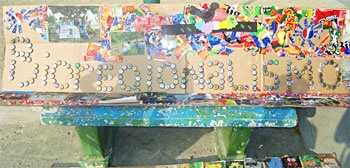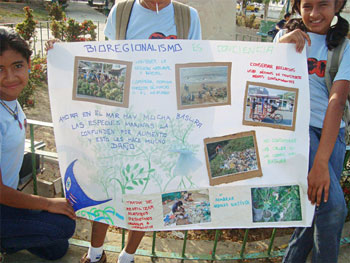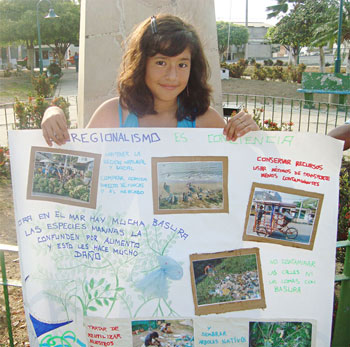Paola’s Report #4
Bioregionalism Education
Summer Session, 2009
Week of Aug. 3, 2009 – English
Photos below
I had no idea what it meant to have an “Open House”, which is what all three Bioregionalism classes were scheduled to have this week. At our Monday meeting, I was told that it meant that each class would display a poster board at their school and explain a little about it; any other details were open for our own interpretation. Clay gave each of us ten dollars to buy supplies for the poster project. I

bought glue, but still had no idea what we would make. This was an opportunity for the kids to show their schoolmates what they had learned in my class; it didn’t make sense to buy new supplies after three months spent emphasizing the importance of reusing and consuming less. I was feeling nervous about the whole thing, so I visited both the other classes that week. Somehow patience is what helped me envision something more suitable to the needs of my conscience.
I met the kids at the park as usual; they were excited to hear that we were going to my house. They had come over on several occasions, typically to drop off the trash we’d pick up on our field trips, but also because during the second month we had wallet-making sessions there. It all started because they were enthralled by my duct tape wallet and wanted me to show them how it was made. Unfortunately, there is no duct tape in this city and if there were it’d be costly, so trash was the next best option. We attempted to make wallets out of interweaving labels that come off of the plastic soda bottles. The consistency was much bulkier than duct tape so I strongly suggested that we make coin purses instead, especially considering we live in a world where one hardly carries bills. But they insisted on wallets. Wallets are classier, I was told. Some made intricate bulky wallets, some made coin purses with ID slots, and Selena even made a purse. It was by far the most gratifying activity I’ve ever done with kids.
The three blocks that we walked to get to my house were filled with questions about what it was we were going to do. I think the thought of having to make a poster board worried them that they would be bored. I explained to them three options to establish who preferred to work in which section. I had Meret and Aaron, other Planet Drum volunteers, as back up, waiting for us inside.

Aaron supervised the kids as they worked on making a sort of title board. They broke down a big old cardboard box to make a flat surface. Then they spelled out the title with glued aluminum bottle caps; the ones we had collected when we made tambourine-like instruments a few months back. Around the edges they glued the pictures we had taken during classes and field trips. Every other blank space was filled in with trash, cut into a sun, a bird and other random shapes. The board was colorful and pleasing to the eyes.

Meret’s station was set up to make a collage using another old box, newspaper and old tourism posters that had pictures of local animals and scenery. They formed a flat board and cut out all the images. When I vaguely explained that they could make a background with the newspaper and then glue anything anywhere, I got blank stares. Andreina, rearranged the newspaper and the pictures every which way. With a puzzled look on her face, she remarked “this needs to look nice señorita, if we’re going to be presenting it”, as if she didn’t think it could. I explained that that’s all we had because it didn’t feel appropriate to buy anything. “Oh, were trying to make this out of trash!” was her immediate response. Suddenly it all made sense to her and everyone else, so they proceeded to paste things arbitrarily. The extent of their imagination did not reach as far as I had hoped; aware of my judgmental presumption, I attribute it to the conventionality of their education system. Fortunately, Meret’s agility and creativity flavored the project and made the mission a success.

The last group of kids formulated the written material. It was challenging for them to determine which subjects to focus on. They started by adding labels on the collage to identify the five characteristics of a Bioregion. I had brought some pictures that I thought were relevant and could guide us. We used a picture of plantains and a picture of fishermen on the beach to explain the importance of buying local food. We demonstrated cleaner means of transportation with a picture of a tricycle taxi. With a picture of a local hillside covered in trash, we stressed the importance of not contaminating our environment. And finally, we included a picture of a volunteer cutting plastic liter bottles and a picture of baby trees inside those cut bottles as an example of how we can reuse products along with how planting native trees can replenish the soil.
Although a bit chaotic with frequent whiny remarks of “are we done yet,” the project making session turned out to be a success. Now came the hardest part; figuring out how we were going to present it to the school. Exciting images of them, illuminating their school about environmental issues through a comedy skit, danced through my mind; but the idea had come too late.
I spoke with the school director to schedule a presentation for the next week. He gave me permission to meet with the kids at their break time to display our posters; also for them to wear their blue Planet Drum T-shirts, something the kids had insisted upon. The thought of having our featured appearance be during recess time muddled inside me. I told the kids that we would display our boards and be available to explain its content.

Our presentation went smoothly; it was a modest way of proposing the idea of “bioregional” awareness. My assistant, Carlitos, and I posted up along the common hang out spot while different classes came out for break time at every hour. Our title and picture board was the one to draw the most attention; people often would rather look at pictures than read. They were engaged by our examples of recycled trash, like the bag and the tambourine. The general question of the day was “what is this all about?” I quickly learned to steer away from using the word “ecology” because I noticed the kids would lose interest, disregarding it, as if it were a foreign insignificant concept. It was a lazy explanation anyway, something I had casually picked up from hearing others describe our class. A few students showed genuine interest in the matter; the majority at least appreciated it as a distraction from their daily routine.
After two long hours, my students finally came out the last hour. They were excited. A few teachers came around and I was enthused that the kids could have the opportunity to tell their teachers about it if they asked. Instead one teacher gave an unnecessarily drawn out comment about how it was hard to read “BiorEgioNaLisMo” because some of the letters were capitalized and other weren’t; it was disappointing and bothersome to me to say the least. Promoting children to expand their minds to new horizons is an easy task; it’s the adults who resist opening their minds and hearts.
Through out the course of the class I asked myself if Bioregionalism is entirely pertinent to the lives of the kids I’ve met. Because they will continue to buy unhealthy prepackaged snacks, they are by nature highly conscious of other matters. They seem to come from upbringings where food, water, fuel and energy are conserved out of necessity. A major problem is how much trash gets thrown out on the hillsides, streets and beaches; a dilemma that’s been deep-rooted as a cultural norm.
If anything, I hope that from our time together they attained more of an instinctual concern for their natural surroundings.
– Paola
Translated by Paola Divita

Reader Interactions